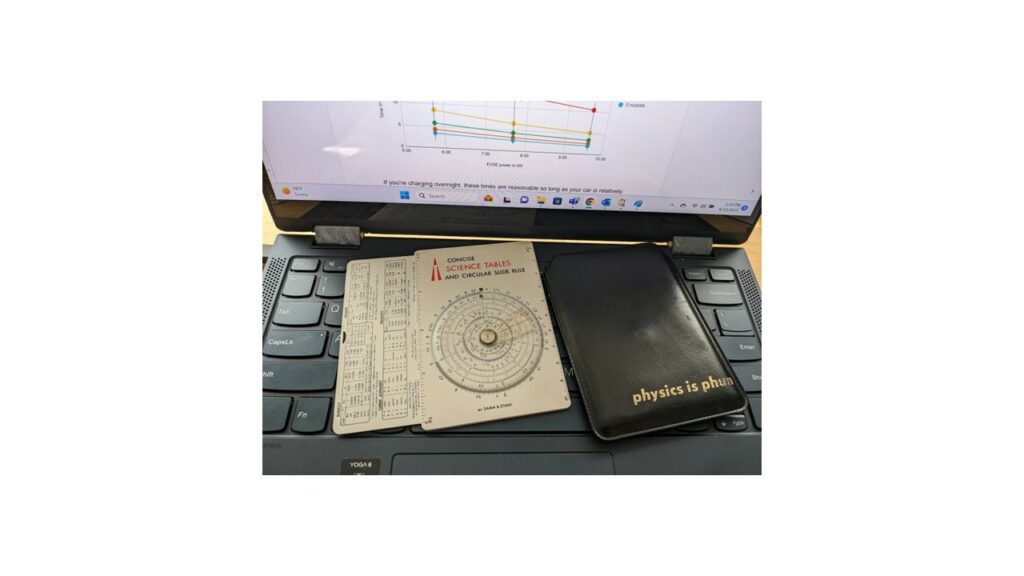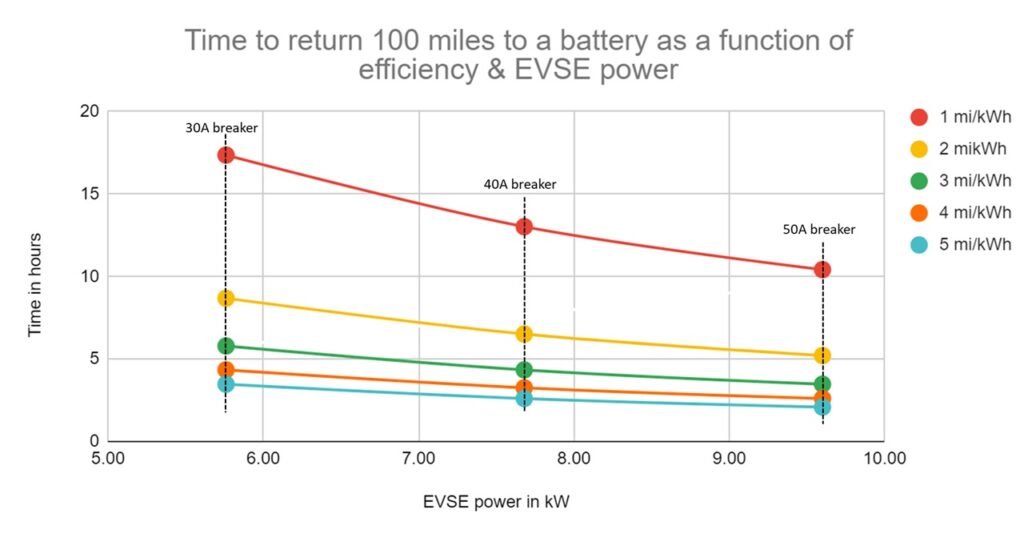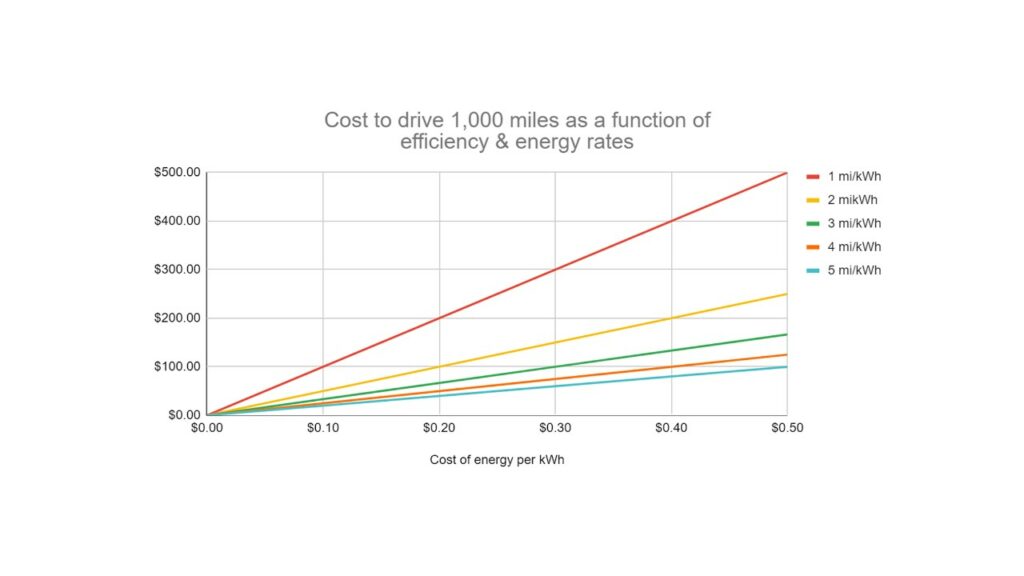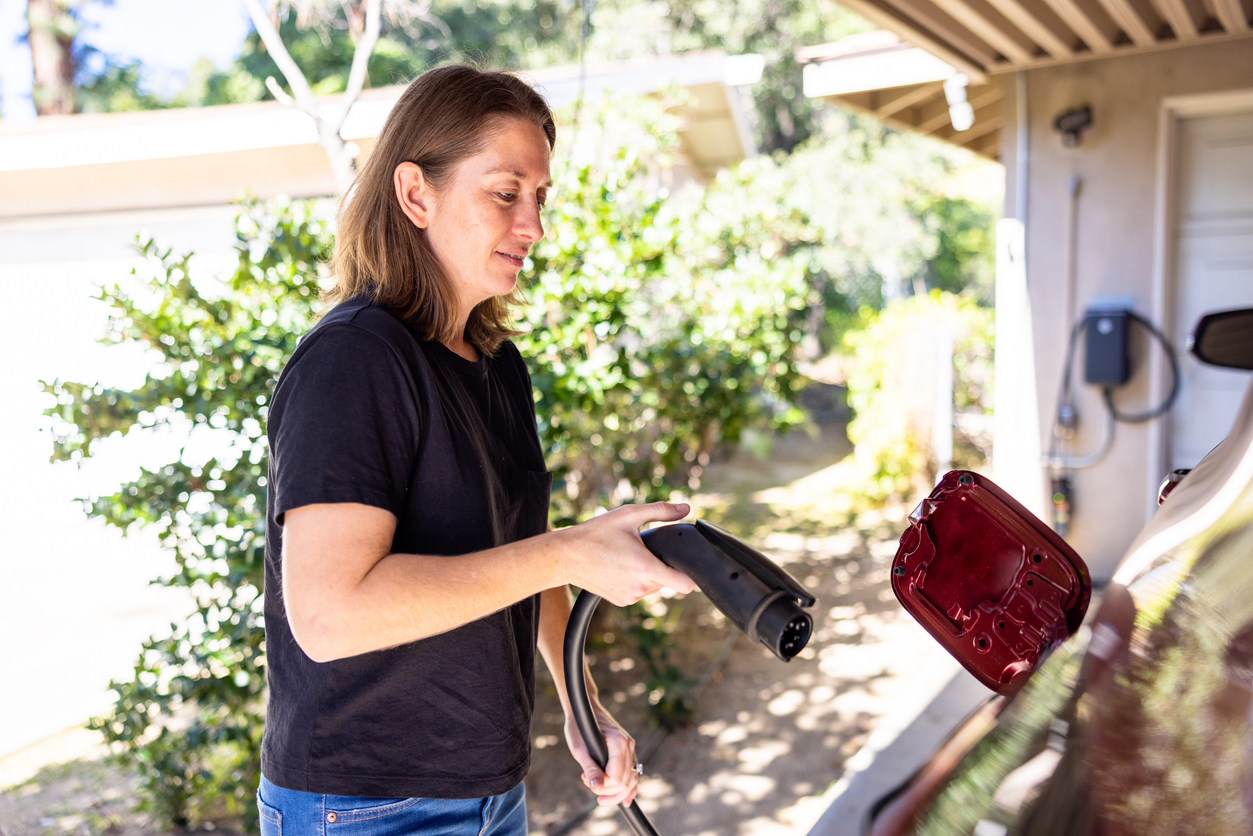TL;DR
How much will it cost to charge my car? How long will it take to charge my car? These questions get asked over and over on social media. The answer is surprisingly simple, yet there are nuances to be aware of – especially when calculating cost.
We have addressed charging costs before in the broad sense, as well as charging speeds for DC Fast Chargers (DCFC). However, since less than 10% of all charging is done at a DCFC, when people ask, “What will it cost to charge my car?” I understand the question to refer to day-to-day charging at home. So let’s zoom in on the costs and duration of charging at home.
There are only four things you need to know to determine how long and how much it will take you to charge your car. First is the charge rate in kilo-Watts (kW), second is the car’s efficiency in kilo-Watt-hours per mile (kWh/mi), third is an estimate of the number of miles you drive per month, and finally, your utility’s cost of electricity. Oh, and a wee bit of high school physics couldn’t hurt, either. Trust me: this will be fun.
The Nitty Gritty Details of Home Charging
Let me start by saying that I have difficulty remembering what I had for breakfast, or even what the Wordle word of the day was, just a few hours after solving the puzzle. It is, therefore, quite understandable that the average person has forgotten a bit of high school physics – especially if they never took it. At the risk of dating myself, when I took high school physics, every student got their own slide rule with “Physics is phun!” emblazoned in gold lettering on the carrying pouch. I still have mine. So let’s jump right in.
Electricity 101
To gain a basic understanding of electrical terms quickly, I’m going to deploy a meme that has been floating around nerd-infested social circles.
- Voltage is the measure of electromotive force (aka EMF, but just think of it as electrical pressure)
- Ohms is a measure of electric resistance
- Amperage is the measure of electrical flow rate – literally the number of electrons passing a point in a circuit
I’ve used water analogies to help explain electricity in this column before. Briefly, electricity flowing in wires can be thought of as water flowing in a pipe. Voltage is like water pressure, amperage is like the water flow rate, and resistance can be thought of as the diameter of the pipe. However, in order to calculate charge durations and cost, what is needed is power and energy, which are not the same things.
Power, in Watts, is simply the product (multiplication) of volts and amps we “defined” in the meme above. Energy is related to power by time – think of it as a quantity of power. Going back to the analogy of water, power is the flow rate, and energy is the total “gallons” delivered. (And yes, I did say current (amps) is analogous to flow rate earlier, but there is a volumetric flow rate and a mass flow rate, and I’m trying to keep it as simple as a useful analogy allows.)
A quick example to bring it home would be that to fill a 10,000 gallon pool in 10 hours, you’d need a a flow rate of 1,000 gallons per hour (10,000/10). To fill a 100 kWh battery in half an hour would require a flow rate of 200 kW (100/0.5).
In summary, power (Watts) is voltage times current (current is typically denoted by the letter I), and energy (kW) is power times time. Expressed mathematically:
- Watts =V*I
- kWh = Watts*hour
- Watts = kWh/hour
This is all the physics you need to know to calculate the time and cost to charge your car. It was fun, wasn’t it?

Just to set the record straight, I do remember how to use a slide rule, but I still did all of the calculations and graphs for today’s column in Excel. Photo credit: John Higham.
Putting It All Together in a Typical Home Setting
Most US homes have two levels of voltage in the walls: 120V and 240V. Far more common, 120V is what runs the lights and supports a typical electrical outlet, formally known as a NEMA 5-15. Higher voltage 240V wiring inside most US homes is reserved for higher power applications like stoves, range tops, dryers, air conditioners, and our favorite topic, EVSEs (electric car chargers).
US building codes require that high-power appliances have a dedicated circuit, so the only item wired to a specific circuit breaker is that appliance. If you have an air conditioner, electric stove top, oven, and dryer in your home, each of these items has its own dedicated circuit breaker just for the said appliance. This contrasts with lower power circuits like lights and outlets that share the same circuit.
Circuit breakers on 240V lines typically come in 30A, 40A, and 50A, but other sizes are, of course, available. US building code also states that for continuous use (meaning the appliance will be on for three hours or more at any given time), the maximum current should be derated to 80% of the breaker’s faceplate rating. Therefore, per the US building code for continuous use, the most you can draw from a 30A breaker is 0.8*30 or 24A. Using what we learned in high school physics, we can create a table of the most power an EVSE should draw from a circuit based on the rating on the breaker (assuming it is wired appropriately by a licensed electrician).
| Breaker rating | Highest power allowed for continuous use at 240V |
| 30A | 240*30*0.8 = 5.76 kW |
| 40A | 7.68 kW |
| 50A | 9.6 kW |
You can get bigger breakers, and many cars today can actually take that much power. But for simplicity’s sake, I will limit the discussion to these three sizes. For a deeper discussion on how much power you need for a home charger, check out Tom’s YouTube video on the topic.
How Long Does It Take to Charge at Home?
Going back to the electricity-water analogy I presented during our high school physics review, think of charging the battery like you would filling a bathtub (or pool). How long does it take to charge? How much are you going to put in, and at what flow rate?
If your EV has a 100 kWh battery and you’re charging from zero, then the answer is pretty simple – you’re going to “fill up” your battery with 100 kWh of electricity. Doing that with 10 kW of power will take 100/10 = 10 hours. It’s as simple as that.
But rarely will you charge your car from zero – this is also Tom’s point in his “How many amps” video I linked above. If you plan to plug in essentially every day, and you typically drive only 40 miles a day, you only need to add 40 “miles’ worth” of energy (electricity) when you plug in. You will also want to consider the atypical case of returning after a long weekend and wanting to be fully charged the next morning. Only you can answer the question of how many miles’ worth of charge you need to return to your car during a charging session.
The missing item in this discussion is the car’s efficiency. For discussion, assume your EV gets 4 mi/kWh. Let’s also assume you’ve decided that you need to reliably charge your car for 100 miles worth of energy. That’s 100/4 = 25 kWh of energy you need to return to the battery. How long will that take?
The final variable in this discussion is how capable your EVSE (charger) is. Assuming that a 7.68 kW hour EVSE returns 100 miles for an EV with an efficiency of 4 mi/kWh, you’d want to calculate (100/4)/7.68 for an answer of about 3 hours and 15 minutes.
Using the EVSE power levels from the table above, and plotting the time to charge for various EV efficiencies and EVSE power levels, yields a family of curves like this:

Just like gas cars get different mileage, EVs have different efficiencies. Expect a mid-sized passenger car to get between 3 and 4 miles for every kWh of energy. Large trucks and SUVs would be closer to 2 mi/kWh. The most efficient EVs get close to 5 mi/kWh when driven gingerly. A table showing the efficiency of various EVs can be found here. For EVs that tend to be in the range of 3~4 mi/kWh efficiency, higher power EVSEs don’t really reduce the charge time as much as one might think. Double the times given for 200 miles or triple for 300 miles. Waking up to a “full tank” every morning is one of the joys of the EV driving experience, which is why when it comes to EV charging, there’s no place like home. Figure by John Higham.
How Much Will It Cost to Charge at Home?
So far this has been a somewhat “math-intense” discussion, but for me at least, this is the hardest question to answer – how much will it cost? Google informs me that there are 1,600 electrical utility companies in the US. Each is going to have its own rate schedule. Electricity rates vary not only by utility but also by time and how much electricity you consume. Whew! That’s a lot of variability.
EnergySage tells me the average electric rate in the US is 23 cents per kWh. It goes on to explain that it can be as low as 10 cents in Idaho and as high as 28 cents in California. But I’m here to tell you that is fake news.
My electric utility, PG&E in California, has time-of-use rate plans that can be as high as $0.53 per kWh during peak summer periods. On the other end of the scale, at least one electric utility in Texas allows you to charge your car for free so long as you do it between 11:00 pm and 6:00 am.
Chances are your utility has a plan that will incentivize you to charge at night. If that plan works for you, great.
Armed with your energy rates, calculating how much it will cost to charge your car at home is as easy as multiplying two numbers together.
For example, if your EV’s efficiency is 4 mi/kWh and you’re paying 25 cents per kWh, it costs you 4*0.25 = $1 to drive a mile. If you drive 1,000 miles per month in that same car, your costs are 1000 miles/4 mi/kWh = 250 kWh per month of energy at $0.25 per kWH is 250*0.25 = $62.50. The graph below shows the costs to drive 1,000 miles for EVs with varying efficiencies.

It is easy to see in the above graph that an EV’s cost per mile strongly depends on your EV’s efficiency and how much you pay for electricity. Important safety tip – if you’re on a budget and live in CA when energy can reach $0.50 per kWh, you might want to stay away from something like the Hummer EV, which gets 1.6 mi/kWh. But if you live in Texas and can charge for free… well, you are in Hummer country. Figure by John Higham.
Next week we will talk about EVs and water. There seems to be a lot of uncertainty out there, so let’s address it head-on.









0 Comments